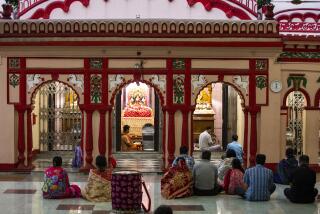New Clashes in an Old Border Feud
- Share via
HARINAGAR, India — The last time Lokesh Chandra Dey heard bullets whizzing past and mortar fire pounding his neighborhood was 35 years ago, when India and archrival Pakistan fought a war that witnessed the creation of Bangladesh.
But on Aug. 9, Dey’s village in the Indian border state of Assam found itself caught in the crossfire again, under a deadly barrage from across the frontier.
“The mortar shells came flying through the ceiling,” Dey said, pointing to the gaping hole in the tin roof of his house, now covered by a black tarp. “Seven people were holed up in that room.... Pieces of brick were strewn all around.... Everything was damaged.”
The attack killed Dey’s daughter-in-law and niece. Three family members were injured.
Skirmishes have erupted lately between India’s Border Security Force and its counterpart across the divide, the Bangladesh Rifles. The two countries share a 2,500-mile border, parts of which are not properly demarcated or are marked by rivers that occasionally shift course, sparking territorial disputes.
Although relations generally have been stable in recent years, tensions along the border have increased since India began fencing off the boundary to keep out what it describes as illegal immigrants and “cross-border insurgents.”
At the same time, some observers fear that political parties in Bangladesh may be fomenting border violence in hopes of capitalizing on anti-India sentiment in upcoming national elections, due by the end of January.
Each country accuses the other of provoking the skirmishes.
Shivajee Singh, inspector general of India’s Border Security Force, said that from Jan. 1, 2005, through last month, more than 30 incidents of “unprovoked firing” by the Bangladesh Rifles led to seven deaths on the Indian side, five of them civilians.
New Delhi alleges that the confrontations are part of an attempt at “infiltration and encroachment” by Bangladesh. The government in Dhaka dismisses the charge, instead blaming “trigger-happy” Indian security forces for outbreaks of violence that it says killed more than 50 Bangladeshi civilians from November to May.
On the Indian side, the remote districts of Cachar and Karimganj in Assam, a poor state that shares a 170-mile land border and about 56 miles of river with Bangladesh, have been hit hard. Local officials say 60 villages and a population of more than 60,000 have been affected.
In the Aug. 9 skirmish, which continued into early the next morning, Indian officials allege that more than 70 Bangladeshi shells were fired at Indian posts, but many of them landed in Harinagar. They also say that the Bangladesh Rifles opened fire with machine guns. Bangladesh contends that its men returned fire only after Indian forces launched about 50 mortar shells at their side.
The shell that hit Dey’s home filled the concrete-and-mud structure with smoke. Dey was not home. By the time he arrived, his daughter-in-law, Sabita, was dead. His 20-year-old niece, Shanta, died minutes later.
Harinagar, a village of about 1,000 people, is scarred by about two dozen craters, some in paddy fields, others in the courtyards of homes. Fear and panic have gripped many residents.
“Many people, especially womenfolk, have moved out of the village and are staying with relatives elsewhere,” said Ranjana Dey, 23, who, like many villagers, has the same last name as Lokesh Chandra but is not related. “Inside most houses, trenches have been dug for shelter.”
At least 1,500 people from Harinagar and three nearby hamlets have abandoned their homes for makeshift relief camps set up by the Assam government. More shooting broke out two days this month, but no casualties were reported.
“Why are they doing this?” asked Benimadhab Dey, a worker in a local cooperative. “Just to grab our land? I don’t buy that.... There must be a deeper conspiracy.”
Indian border police say the skirmishes are partly attempts by local Bangladeshi officials to encroach on vacant land for growing crops and grazing cattle.
But beyond that, they allege that local Bangladeshi politicians are encouraging hostilities in a bid to increase support for the central government, led by the Bangladesh Nationalist Party. The ruling coalition in Dhaka is wary of New Delhi, which it suspects of covertly supporting opposition parties.
Indian border officials are worried that outbreaks of violence will persist until Bangladesh goes to the polls.
Singh, of the Indian border force, expressed hope that the tension could be eased through regular meetings with his Bangladeshi counterparts. Senior commanders from both forces met for four days last month in the Indian city of Shillong to discuss how to restore calm.
As they were meeting, however, a brief gun battle erupted near Harinagar.
In spite of the violence, many villagers say they have no plans of leaving their homes.
“We have inhabited this village for over 200 years now,” Lokesh Chandra Dey said, “so there is no question of us vacating this place and moving elsewhere.”
More to Read
Sign up for Essential California
The most important California stories and recommendations in your inbox every morning.
You may occasionally receive promotional content from the Los Angeles Times.










